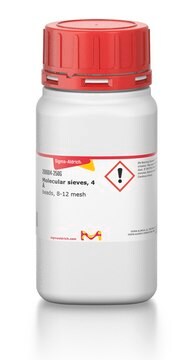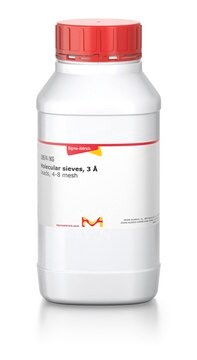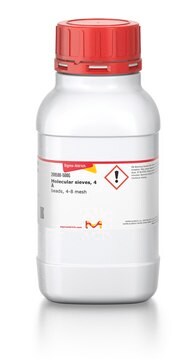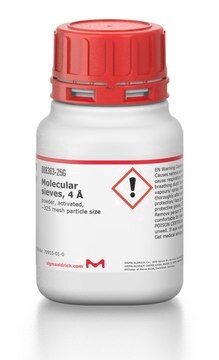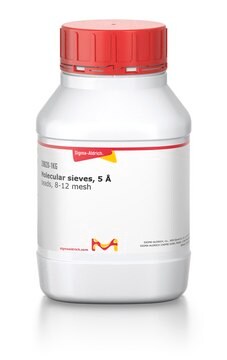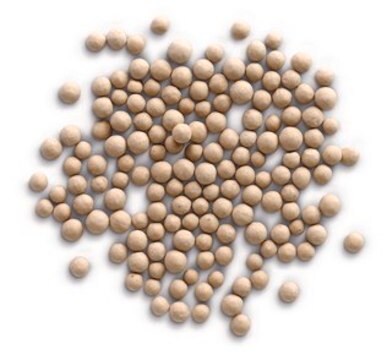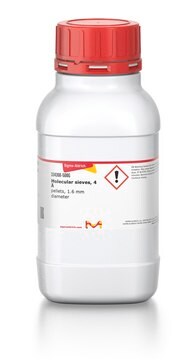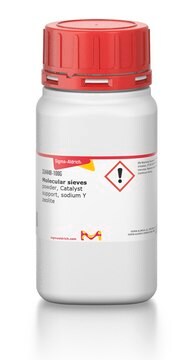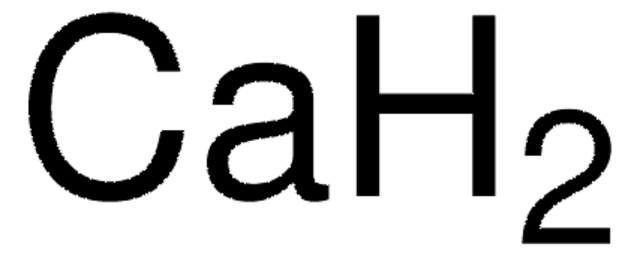208582
Molecular sieves, 3 Å
beads, 8-12 mesh
Sinonimo/i:
Molekularsieb UOP Typ 3A
Autenticatiper visualizzare i prezzi riservati alla tua organizzazione & contrattuali
About This Item
Formula condensata:
KnNa12-n[(AlO2)12(SiO2)12] · xH2O
Numero CAS:
Numero MDL:
Codice UNSPSC:
23201100
eCl@ss:
32110204
NACRES:
NB.24
Prodotti consigliati
Cerchi prodotti simili? Visita Guida al confronto tra prodotti
Categorie correlate
Descrizione generale
Choosing a Molecular Sieve:
1. The preferential adsorption of one molecule over another depends upon pore diameter and mesh size.
2. The dynamic capacity of the silica gel for adsorbing a particular compound is governed by the internal surface area; the greater the surface area, the greater the dynamic capacity.
3. Rate of adsorption and sharpness of resolution are dependent chiefly on particle size and column packing; a fine particle size gives optimum sharpness of resolution.
4. Liquids are most readily adsorbed from solvents in which they are least soluble; a good solvent makes a good desorbing agent.
5. Highly polar liquids are readily adsorbed. Compounds having hydroxyl groups, or containing oxygen are strongly adsorbed.
6. For similar compounds, the higher the molecular weight the higher the selectivity.
7. For hydrocarbons of similar molecular weight, adsorptivity increases with the number of double bonds.
1. The preferential adsorption of one molecule over another depends upon pore diameter and mesh size.
2. The dynamic capacity of the silica gel for adsorbing a particular compound is governed by the internal surface area; the greater the surface area, the greater the dynamic capacity.
3. Rate of adsorption and sharpness of resolution are dependent chiefly on particle size and column packing; a fine particle size gives optimum sharpness of resolution.
4. Liquids are most readily adsorbed from solvents in which they are least soluble; a good solvent makes a good desorbing agent.
5. Highly polar liquids are readily adsorbed. Compounds having hydroxyl groups, or containing oxygen are strongly adsorbed.
6. For similar compounds, the higher the molecular weight the higher the selectivity.
7. For hydrocarbons of similar molecular weight, adsorptivity increases with the number of double bonds.
Molecular sieves are crystalline metal aluminosilicates having a three-dimensional interconnecting network of silica and alumina tetrahedra. Natural water of hydration is removed from this network by heating to produce uniform cavities which selectively adsorb molecules of a specific size. The 3A form is made by substituting potassium cations for the inherent sodium ions of the 4A structure, reducing the effective pore size to ~3Å, excluding molecules of diameter >3Å (for example: ethane). The 8 to 12-mesh type is common in liquid-phase applications. Molecular sieves are considered a universal drying agent in polar and nonpolar media.
Molecular sieves, 3Å is a UOP-type zeolite 3Å.It is widely employed as a sorbent.
Regeneration or Activation:
A saturated molecular sieve can be restored to its original capacity by regeneration, the principle of which involves changing the conditions surrounding the adsorbent to correspond to a very low equilibrium capacity. In general, the greater the difference between the equilibrium capacities of adsorption and regeneration, the more rapid and complete the regeneration.
The sieve may be regenerated in one of four ways:
1. Thermal reactivation –The maximum regeneration temperature for Silica is 300°C.
2. Pressure reactivation
3. Passing an appropriate fluid through the gel bed at normal temperature and pressure.
4. Displacement of adsorbates by passing a high concentration of molecules in a fluid through the bed.
A saturated molecular sieve can be restored to its original capacity by regeneration, the principle of which involves changing the conditions surrounding the adsorbent to correspond to a very low equilibrium capacity. In general, the greater the difference between the equilibrium capacities of adsorption and regeneration, the more rapid and complete the regeneration.
The sieve may be regenerated in one of four ways:
1. Thermal reactivation –The maximum regeneration temperature for Silica is 300°C.
2. Pressure reactivation
3. Passing an appropriate fluid through the gel bed at normal temperature and pressure.
4. Displacement of adsorbates by passing a high concentration of molecules in a fluid through the bed.
The kinetics of the adsorption of water-vapor by employing molecular sieve 3Å has been studied in various temperature ranges (25-80°C and water dew points from -69 to 17°C).
Applicazioni
Molecular sieves, 3 Å may be used in the following processes:
- Commercial dehydration of unsaturated hydrocarbon streams, including cracked gas, propylene, butadiene, acetylene.
- Drying polar liquids such as methanol and ethanol.
- Adsorption of molecules such as ammonia and water from a N2/H2 flow.
Codice della classe di stoccaggio
11 - Combustible Solids
Classe di pericolosità dell'acqua (WGK)
WGK 3
Punto d’infiammabilità (°F)
Not applicable
Punto d’infiammabilità (°C)
Not applicable
Scegli una delle versioni più recenti:
Possiedi già questo prodotto?
I documenti relativi ai prodotti acquistati recentemente sono disponibili nell’Archivio dei documenti.
Adsorption of H2O and dimethyl carbonate at high pressure over zeolite 3A in fixed bed column
Santos, Bruno AV, et al.
Industrial & Engineering Chemistry Research, 53.6, 2473-2483 (2014)
Kinetics of water vapor adsorption on single-layer molecular sieve 3A: Experiments and modeling.
Lin R, et al.
Industrial & Engineering Chemistry Research, 53(41), 16015-16024 (2014)
Global Trade Item Number
| SKU | GTIN |
|---|---|
| 208582-5KG | 4061838769978 |
| 208582-1KG | 4061838769961 |
Il team dei nostri ricercatori vanta grande esperienza in tutte le aree della ricerca quali Life Science, scienza dei materiali, sintesi chimica, cromatografia, discipline analitiche, ecc..
Contatta l'Assistenza Tecnica.